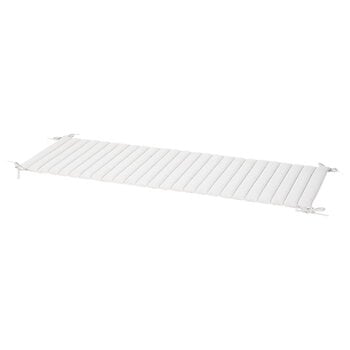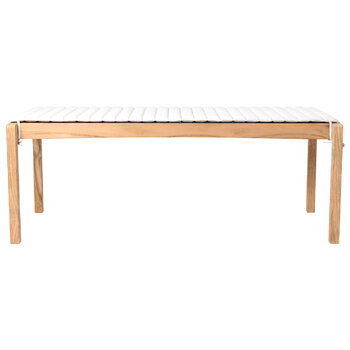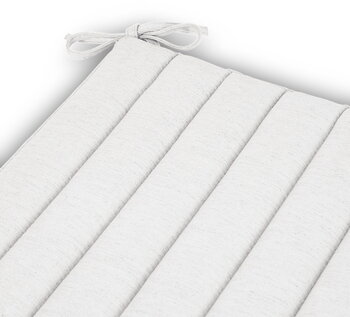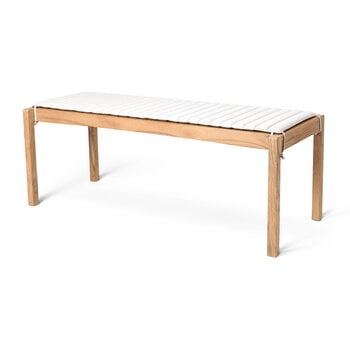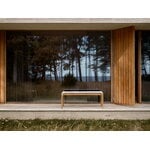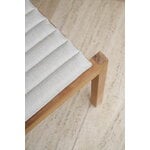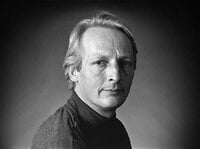This seat cushion is designed for Carl Hansen & Søn’s AH912 bench from the AH Outdoor series. The furniture itself can be used as a side table as well as a bench – this cushion adds a bit of extra comfort when the piece is used as a seat. The quilted cushion is made of a durable outdoor textile and finished with nifty straps to hold it in place.
AH912 seat cushion, Agora Life Oat
Carl Hansen & Søn
Description
This seat cushion is designed for Carl Hansen & Søn’s AH912 bench from the AH Outdoor series. The furniture itself can be used as a side table as well as a bench – this cushion adds a bit of extra comfort when the piece is used as a seat. The quilted cushion is made of a durable outdoor textile and finished with nifty straps to hold it in place.
Product details (13)
- Material
- Recycled and waterproof textile
- Colour
- Off-white
- Length
- 48.03 in (122 cm)
- Width
- 15.55 in (39.5 cm)
- Height
- 0.98 in (2.5 cm)
- Fabric
-
Agora Life Oat 1760: 78% solution-dyed acrylic, 22% recycled solution-dyed acrylic.
Fluorine free finish and a high degree of durability. - Abrasion resistance
- Martindale 25 000
- Pilling
- 5/5
- Lightfastness
- 7/8
- Filling
- HR foam
- Removable cover
- No
- Notes
- This seat cushion is suitable for AH912 Outdoor (table) bench.
- Care instructions
- Remove loose dirt with a soft brush or vacuum cleaner. Use a mild soap solution to clean the fabric.
- Product ID
Designer
Danish Alfred Homann (1948–2022) was an award-winning architect and designer who conceived museums, railway stations and other public buildings as well as private homes during his career. Known for his unadorned and functional style, Homann designed not only buildings but also furniture – he collaborated with the likes of prestigious furniture brand Carl Hansen & Søn. Homann also designed several lighting models, but exclusively for lighting manufacturer Louis Poulsen.
Alfred Homann graduated as an architect from the Royal Danish Academy of Fine Arts in 1976. Already during his studies, he worked under several Danish and American architects, but two years after his graduation – when he was 30 years old – he decided to found his first very own design studio. In addition to his studio in Copenhagen, Homann also worked in the United States during his career, where he had a design agency called Homann Design Inc. between 1987 and 1995.
View all productsReviews (0)
Sustainability
The Product Sustainability Framework, our criteria of sustainable design, helps you find the most sustainable products in our selection. Read below which sustainability criteria this product has met.
Working conditions & labour 8/9
-
Equal opportunities for all employees
-
Commitment to UN Global Compact, fair compensation for all employees
-
Corporate responsibility requirements defined and communicated for suppliers
-
Systematic work for improved inclusion and well-being in the workplace
-
Transparent supply chain
-
Suppliers' compliance to a code of conduct ensured
-
Compliance to the UN Guiding Principles on Business and Human Rights ensured in the supply chain
-
Support for community involvement in the supply chain
-
Direct suppliers audited and certified
Eco-friendly production 7/9
-
Fair and resource-wise water-use in production
-
No incineration or landfilling of returned items
-
No use of endangered species as materials
-
No direct environmental emissions or waste (excl. GHGs) from production
-
The sustainability of direct suppliers' production is addressed and monitored
-
Material-efficient and ecological packaging
-
No potentially harmful chemicals used in own production
-
Production and material sourcing that respect biodiversity, animal rights, and natural ecosystems
-
Positive impact on nature’s well-being through operations that regenerate natural ecosystems
Climate impact 6/8
-
Company's direct greenhouse gas emissions identified and commitment to reduction
-
Product's carbon impact identified and commitment to reduction
-
Guidance on energy- and eco-efficient use of the product
-
Contribution to climate initiatives beyond the brand’s direct operations
-
Low-carbon or compensated transportation
-
100 % renewable energy in own production and operations
-
Carbon footprint of the product calculated and goals set to reduce it
-
Carbon neutral or carbon negative product
Sustainable materials 6/6
-
Sustainable and long-lasting material choices
-
No harmful or hazardous substances
-
Responsible raw material sourcing and production
-
Materials suited for circularity: monomaterials, recyclable finishings, renewable or recycled contents etc.
-
Ecological materials: natural, biodegradable, recyclable or recycled contents
-
Outstanding materials in terms of innovativeness, responsibility, sustainability and circularity: local production or sourcing, 100 % recycled content, C2C-certification etc.
Circular design 5/5
-
High aesthetic quality promoting long-term use of the product
-
Technically durable product design and material choices
-
Design for enduring life-long quality
-
Design and support for product maintenance, repair and upgradability
-
Innovative circular design solutions: circular service system, resale platform, remanufacturing, collection of used products, etc.

